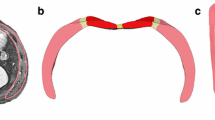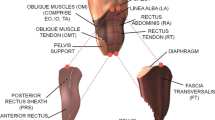Abstract
The absence of universally and accepted guidelines to select the most appropriate surgical mesh for each patient and type of defect in hernia surgery could complicate surgeons decisions when choosing the surgical mesh and deciding which is the best orientation of the mesh in the abdomen. An interdisciplinary work between clinicians and engineers may lead to great advances in medical protocols through the development of computational methodologies which could reduce the long periods of time and high costs involved by experimental research procedures. Numerical simulations of hernia treatment could also allow a better knowledge of the post-operative condition. This work is projected to define a computational methodology based on experimental techniques that would help surgeons in deciding which prosthesis is the most convenient depending on the type of abdominal hernia defect and particularities of the patient so current treatments and procedures could be improved with regard to the quality of patient life.
Access this chapter
Tax calculation will be finalised at checkout
Purchases are for personal use only
Similar content being viewed by others
References
Bauer JJ, Harris MT, Gorfine SR, Kreel I (2002) Rives-stoppa procedure for repair of large incisional hernias: experience with 57 patients. Hernia 6:120–123
Bellón JM, Rodríguez M, García-Honduvilla N, Gómez-Gil V, Pascual G, Buján J (2009) Comparing the behavior of different polypropylene meshes (heavy and lightweight) in an experimental model of ventral hernia repair. J Biomed Mater Res Part B Appl Biomater 89B(2):448–455
Cobb WS, Burns JM, Kercher KW, Matthews BD, Norton HJ, Heniford BT (2005) Normal intraabdominal pressure in healthy adults. J Surg Res 129:231–235
Demiray H, Weizsacker HW, Pascale K, Erbay H (1988) A stress-strain relation for a rat abdominal aorta. J Biomech 21:369–374
Flory PJ (1961) Thermodynamic relations for high elastic materials. Trans Faraday Soc 57:829–838
Hernández B, Peña E, Pascual G, Rodríguez M, Calvo B, Doblaré M, Bellón JM (2011) Mechanical and histological characterization of the abdominal muscle: a previous step to model hernia surgery. J Mech Behav Biomed Mater 4:392–404
Hernández-Gascón B, Mena A, Peña E, Pascual G, Bellón JM, Calvo B (2013) Understanding the passive mechanical behavior of the human abdominal wall. Ann Biomed Eng 41(2):433–444
Hernández-Gascón, B, Peña E, Grasa J, Pascual G, Bellón JM, Calvo B (2013) Mechanical response of the herniated human abdomen to the placement of different prostheses. J Biomech Eng (135) 051004–8
Hernández-Gascón B, Peña E, Melero H, Pascual G, Doblaré M, Ginebra MP, Bellón JM, Calvo B (2011) Mechanical behaviour of synthetic surgical meshes: finite element simulation of the herniated abdominal wall. Acta Biomater 7:3905–3913
Holzapfel GA (2000) Nonlinear solid mechanics. Wiley, New York
Holzapfel GA (2006) Determination of material models for arterial walls from uniaxial extension tests and histological structure. J Theor Biol 238:290–302
Holzapfel GA, Gasser TC, Ogden RW (2000) A new constitutive framework for arterial wall mechanics and a comparative study of material models. J Elast 61:1–48
Hwang W, Carvalho JC, Tarlovsky I, Boriek AM (2005) Passive mechanics of canine internal abdominal muscles. J Appl Physiol 98(5):1829–1835
Junge K, Klinge U, Prescher A, Giboni P, Niewiera M, Shumpelick V (2001) Elasticity of the anterior abdominal wall and impact for reparation of incisional hernia using mesh implants. Hernia 5:112–118
Kauer M (2001) Inverse finite element characterization of soft tissues with aspiration experiments. Ph.D. thesis, Swiss Federal Institute of Technology, Znrich
Kingsnorth A, LeBlanc K (2003) Hernias: inguinal and incisional. Lancet 362:1561–1574
Klinkel S, Govindjee S (2002) Using finite strain 3D-material models in beam and shell elements. Eng Comput 19(8):902–921
Marquardt DW (1963) An algorithm for least-squares estimation of nonlinear parameters. SIAM J Appl Math 11:431–441
Martins P, Peña E, Jorge RMN, Santos A, Santos L, Mascarenhas T, Calvo B (2012) Mechanical characterization and constitutive modelling of the damage process in rectus sheath. J Mech Behav Biomed Mater 8:111–122
Moore W (2008) Gray’s Anatomy celebrates 150th anniversary. The Telegraph (Telegraph Media Group)
Nilsson T (1982) Biomechanical studies of rabbit abdominal wall. Part I. - The mechanical properties of specimens from different anatomical positions. J Biomech 15(2):123–129
Nilsson T (1982) Biomechanical studies of rabbit abdominal wall. Part II.- The mechanical properties of specimens in relation to length, width, and fibre orientation. J Biomech 15(2):131–135
Norasteh A, Ebrahimi E, Salavati M, Rafiei J, Abbasnejad E (2007) Reliability of B-mode ultrasonography for abdominal muscles in asymptomatic and patients with acute low back pain. J Bodywork Mov Ther 11:17–20
Pascual G, Rodríguez M, Gómez-Gil V, García-Honduvilla N, Buján J, Bellón JM (2008) Early tissue incorporation and collagen deposition in lightweight polypropylene meshes: bioassay in an experimental model of ventral hernia. Surgery 144:427–435
Peña E, del Palomar AP, Calvo B, Martínez MA, Doblaré M (2007) Computational modelling of diarthrodial joints. Physiological, pathological and pos-surgery simulations. Arch Comput Methods Eng 14(1):47–91
Podwojewski F, Otténio M, Beillas P, Guérin G, Turquier F, Mitton D (2012) Mechanical response of animal abdominal walls in vitro: evaluation of the influence of a hernia defect and a repair with a mesh implanted intraperitoneally. J Biomech 46(3):561–566
Sabbagh C, Dumont F, Robert B, Badaoui R, Verhaeghe P, Regimbeau JM (2011) Peritoneal volume is predictive of tension-free fascia closure of large incisional hernias with loss of domain: a prospective study. Hernia 15(5):559–565
Song C, Alijani A, Frank T, Hanna G, Cuschieri A (2006) Mechanical properties of the human abdominal wall measured in vivo during insufflation for laparoscopic surgery. Surg Endosc 20:987–990
Weiss JA, Maker BN, Govindjee S (1996) Finite element implementation of incompressible, transversely isotropic hyperelasticity. Comput Methods Appl Mech Eng 135:107–128
Acknowledgments
This study was supported by the Spanish Ministry of Economy and Competitiveness through research project DPI2011-27939-C02-01/C02-02, the Spanish Ministry of Science and Innovation through research project DPI2011-15551-E and the Instituto de Salud Carlos III (ISCIII) through the CIBER initiative project ABDOMESH. B. Hernández-Gascón was also funded by a grant (BES-2009-021515) from the Spanish Ministry of Science and Technology.
Author information
Authors and Affiliations
Corresponding author
Editor information
Editors and Affiliations
Rights and permissions
Copyright information
© 2014 Springer International Publishing Switzerland
About this chapter
Cite this chapter
Hernández-Gascón, B., Peña, E., Pascual, G., Bellón, J.M., Calvo, B. (2014). Can Numerical Modelling Help Surgeons in Abdominal Hernia Surgery?. In: Di Giamberardino, P., Iacoviello, D., Natal Jorge, R., Tavares, J. (eds) Computational Modeling of Objects Presented in Images. Lecture Notes in Computational Vision and Biomechanics, vol 15. Springer, Cham. https://doi.org/10.1007/978-3-319-04039-4_10
Download citation
DOI: https://doi.org/10.1007/978-3-319-04039-4_10
Published:
Publisher Name: Springer, Cham
Print ISBN: 978-3-319-04038-7
Online ISBN: 978-3-319-04039-4
eBook Packages: EngineeringEngineering (R0)




